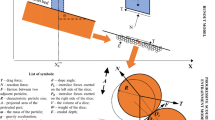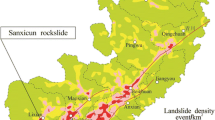Abstract
At 8:30 a.m., on August 11, 2018, a high-position rockslide avalanche was reported in Da’anshan village, Fangshan district, Beijing, China. The landslide destroyed the road below and did not cause any casualties due to the timely detection of warning signs. The displaced landslide material traveled a horizontal distance of about 260 m with a vertical drop of about 176 m and stopped at 613.6 m asl. According to videos and survey data, the Da’anshan rockslide initiated at a high position and transformed into a pipeline-type debris avalanche along the gully to the east. It scraped the surface layer of the strongly weathered rock formation and also transformed into a diffuse-type debris flow along the slope surface. Finally, it accumulated at the bottom of the river valley and presented a typical disaster mode of rapid runout. Based on this, the Archard erosion model was embedded in the Engineering Discrete Element Method (EDEM) to perform back analysis and simulate the three-stage kinematic processes of sliding, shear-shoveling, and flow accumulation to quantify the scraping volume and position. After initiation at a high-level position, the rockslide moved downward along the valley for approximately 10 s with a maximum velocity of 26.1 m/s. The final volume of the accumulation obtained from the simulation was ~24,000 m3, which is close to the total volume obtained from the field investigations. This study provides a methodological reference for future simulation analysis of high-position rockslide avalanches.















Similar content being viewed by others
References
Archard JF (1980) Wear theory and mechanisms. Wear control handbook. American Society of Mechanical Engineers, New York. 35–80
Cagnoli B, Piersanti A (2017) Combined effects of grain size, flow volume and channel width on geophysical flow mobility: three-dimensional discrete element modeling of dry and dense flows of angular rock fragments. Solid Earth 8:177–188
Chen XZ, Cui Y (2017) The formation of the Wulipo landslide and the resulting debris flow in Dujiangyan City, China. Journal of Mountain Science 14(6):1100–1112
Chen KT, Wu JH (2018) Simulating the failure process of the xinmo landslide using discontinuous deformation analysis. Eng Geol 239:269–281
Cundall PA, Strack O (1979) A discrete numerical model for granular assemblies. Geotechnique 29:47–65
Davies T, McSaveney MJ (1999) Runout of dry granular avalanches. Can Geotech J 36:313–320
De Blasio FV, Crosta GB (2013) Simple physical model for the fragmentation of rock avalanches. Acta Mech 225(1):243–252
DEM Solutions: EDEM 2.6 (2014) Theory Reference Guide, Edinburgh, United Kingdom 2014
Deng JH, Gao YJ, Yu ZQ, Xie HP (2019) Analysis on the formation mechanism and process of baige Landslides damming the upper reach of Jinsha River, China. Advanced Engineering Sciences 51(1):9–16 (in Chinese)
Do TN, Wu JH (2020) Simulating a mining-triggered rock avalanche using dda: a case study in nattai north, Australia. Eng Geol 264:105386
Estep J, Dufek J (2013) Discrete element simulations of bed force anomalies due to force chains in dense granular flows. Journal of Volcanology & Geothermal Research 254(254):108–117
Fan XM, Xu Q, Alonso-Rodriguez A, Subramanian S, Li WL, Zheng G, Dong XJ, Huang RQ (2019) Successive landsliding and damming of the Jinsha River in eastern Tibet, China: prime investigation, early warning, and emergency response. Landslides 16(5):1003–1020
Gauer P, Issler D (2004) Possible erosion mechanism in snow avalanches. Ann Glaciol 38:384–392
He K, Yin YP, Li B, Feng Z (2015) Video imaged based analysis of motion characteristic for tower rock collapse. J Eng Geol 23(1):86–92 (in Chinese)
Hertz H (1882) Ueber die Berührung fester elastischer Körper. J Reine Angew Math 92:156–171
Huang BL, Yin YP, Liu GN, Wang SC, Chen XT, Huo ZT (2012) Analysis of waves generated by Gongjiafang landslide in Wu gorge, three gorges reservoir, on November 23, 2008. Landslides 9(3):395–405
Hungr O (1995) A model for the run out analysis of rapid flow slides, debris flows, and avalanches. Can Geotech J 32:610–623
Hungr O, McDougall S (2009) Two numerical models for rockslide dynamic analysis. Comput Geosci 35:978–992
Iverson RM, Ouyang CJ (2015) Entrainment of bed material by earth-surface mass flows: review and reformulation of depth-integrated theory. Rev Geophys 53:27–58
Kang C, Chan D (2018a) Numerical simulation of 2D granular flow entrainment using DEM. Granul Matter 20(13):1–17
Kang C, Chan D (2018b) A progressive entrainment runout model for debris flow analysis and its application. Geomorphology 323:25–40
Li QG, Zhang SD, Wu B (2020) Study on mechanics mechanism and geological evolution model of large landslide in mining area. Coal Science and Technology 48(3):214–220 (in Chinese)
Lisjak A, Grasselli G (2014) A review of discrete modeling techniques for fracturing processes in discontinuous rock masses. J Rock Mech Geotech Eng 6(4):301–314
Liu D, Cui Y, Guo J, Yu Z, Chan D, Lei M (2020) Investigating the effects of clay/sand content on depositional mechanisms of submarine debris flows through physical and numerical modeling. Landslides 17:1863–1880
Mindlin RD (1949) Compliance of elastic bodies in contact. J Appl Mech 16:259–268
Mindlin RD, Deresiewicz H (1953) Elastic spheres in contact under varying oblique forces. J Appl Mech 20:327–344
Ouyang CJ, An HC, Zhou S, Wang ZW, Su PC, Wang DP, Cheng DX, She JX (2019) Insights from the failure and dynamic characteristics of two sequential landslides at Baige village along the Jinsha River, China. Landslides 16(7):1397–1414
Powell MS, Weerasekara NS, Cole S, Laroche RD, Favier J (2011) Dem modelling of liner evolution and its influence on grinding rate in ball mills. Miner Eng 24(3–4):341–351
Sakaguchi E, Ozaki E, Igarashi T (1993) Plugging of the flow of granular materials during the discharge from a silo. Int J Mod Phys B 7:1949–1963
Sassa K, Nagai O, Solidum R et al (2010) An integrated model simulating the initiation and motion of earthquake and rain induced rapid landslides and its application to the 2006 Leyte landslide. Landslides 7(3):219–236
Sassa K, He B, Dang K, Nagai O, Takara K (2014) Plenary: progress in landslide dynamics. In: Sassa K, Canuti P, Yin YP (Eds.), Landslide science for a safer geoenvironment. Switzerland: Springer International Publishing; 37–67
Savage SB, Hutter K (1989) The motion of a finite mass of granular material down a rough incline. J Fluid Mech 199:177–215
Shang J (2020) Rupture of veined granite in polyaxial compression: insights from three-dimensional discrete element method modeling. Journal of Geophysical Research: Solid Earth, 125, e2019JB019052. https://doi.org/10.1029/2019JB019052
Stark TD, Edi HT, Evans WD, Sherry PE (2000) Municipal solid waste slope failure. II: stability analyses. J Geotech Geoenviron Eng 126(5):408–419
Wang YS, Zhao B, Li J (2018) Mechanism of the catastrophic June 2017 landslide at Xinmo Village, Songping River, Sichuan Province, China. Landslides 15(2):333–345
Wang WP, Yin YP, Zhu SN, Wang LC, Zhang N, Zhao RX (2020) Investigation and numerical modeling of the overloading-induced catastrophic rockslide avalanche in Baige, Tibet, China. Bull Eng Geol Environ 79:1765–1779
Wu JH, Do TN, Chen CH et al (2016) New geometric restriction for the displacement–constraint points in discontinuous deformation analysis. International Journal of Geomechanics 17(5):E4016002
Wu JH, Lin WK, Hu HT (2017) Assessing the impacts of a large slope failure using 3DEC: the Chiu-fen-erh-Shan residual slope. Comput Geotech 88:32–45
Wu JH, Lin WK, Hu HT (2018) Post-failure simulations of a large slope failure using 3DEC: the hsien-du-Shan slope. Eng Geol 242:92–107
Xing AG, Wang GH, Li B et al (2014) Long-runout mechanism and landsliding behaviour of large catastrophic landslide triggered by heavy rainfall in Guanling, Guizhou, China. Can Geotech J 52(7):971–981
Xu Q, Zheng G, Li WL, He CY, Dong XJ, Guo C, Feng WK (2018) Study on successive landslide damming events of Jinsha River in Baige Village on Octorber 11 and November 3, 2018. J Eng Geol 26(6):1534–1551 (in Chinese)
Yin YP, Cheng YL, Liang J, Wang WP, et al (2016) Heavy-rainfall-induced catastrophic rockslide debris flow at Sanxicun, Dujiangyan, after the Wenchuan Ms 8.0 earthquake.Landslides 13(1):9–23
Yin YP, Wang WP, Zhang N, Yan JK, Wei YJ, Yang LW (2017) Long runout geological disaster initiated by the ridge-top rockslide in a strong earthquake area: a case study of the Xinmo landslide in Maoxian County, Sichuan Province. Geol China 44(5):827–841 (in Chinese)
Zhang M, McSaveney MJ (2017) Rock avalanche deposits store quantitative evidence on internal shear during runout. Geophys Res Lett 44(17):8814–8821
Zhang YS, Cheng YL, Yin YP, Lan HX (2014) High-position debris flow: a long-term active geohazard after the wenchuan earthquake. Eng Geol 180(180):45–54
Zhao ZH, Li M (2018) Characteristics and cause analysis of the slope geologic disaster near the road from Junxiang to Hongmeichang in Fangshan District, Beijing. Urban Geology 13(4):32–36 (in Chinese)
Zhao T, Crosta GB, Dattola G, Utili S (2018) Dynamic fragmentation of jointed rock blocks during rockslide-avalanches: insights from discrete element analyses. Journal of Geophysical Research Solid Earth 123(4):3250–3269
Zheng G, Xu Q, Ju YZ, Li WL, Zhou XP, Peng SQ (2018) The Pusacun rockavalanche on august 28, 2017 in Zhangjiawan Nayongxian, Guizhou: characteristics and failure mechanism. J Eng Geol 1:229–246 (in Chinese)
Zhou GGD, Sun QC (2013) Three-dimensional numerical study on flow regimes of dry granular flows by DEM. Powder Technol 239:115–127
Zhou S, Ouyang CJ, An HC, Jiang TH, Xu QS (2020) Comprehensive study of the Beijing daanshan rockslide based on real-time videos, field investigations, and numerical modeling. Landslides, 17, pages1217-1231
Acknowledgments
We are grateful to Beijing Institute of Geology and China Academy of Safety Science & Technology for supplying some basic data. Besides, we are also grateful to the editor-in-chief of Bulletin of Engineering Geology and the Environment, Resat Ulusay, for reconsidering the revised manuscript. Finally, the authors would like to thank the reviewers of this manuscript for their good suggestions and useful comments.
Funding
Financial support was provided by the National Key R&D Program of China (Grant No. 2018YFC1505404), National Natural Science Foundation of China (No. 41731287), Beijing Natural Science Foundation (Grant No. 8194062), and Geological Disaster Detailed Investigation Project of China Geological Survey (Grant No. DD20190637).
Author information
Authors and Affiliations
Corresponding author
Rights and permissions
About this article
Cite this article
Wang, W., Yin, Y., Wei, Y. et al. Investigation and characteristic analysis of a high-position rockslide avalanche in Fangshan District, Beijing, China. Bull Eng Geol Environ 80, 2069–2084 (2021). https://doi.org/10.1007/s10064-020-02098-x
Received:
Accepted:
Published:
Issue Date:
DOI: https://doi.org/10.1007/s10064-020-02098-x




